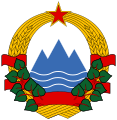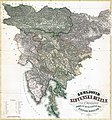The Slovenia Portal
 |

|
 | |
Slovenia (/sloʊˈviːniə, slə-/ ⓘ sloh-VEE-nee-ə; Slovene: Slovenija [slɔˈʋèːnija]) officially the Republic of Slovenia (Slovene: (Full article...)
Selected article -

The Slovenian football champions are the winners of the highest league of association football in Slovenia, PrvaLiga. Also known by the abbreviation 1. SNL, PrvaLiga is contested on a round-robin basis and the championship is awarded to the club that finishes top of the league at the end of the season. The league was established after the independence of Slovenia in 1991, originally containing 21 clubs. Before that, Maribor, Nafta Lendava and Olimpija were the only Slovenian teams who participated in the Yugoslav top division, Yugoslav First League, between the end of World War II in 1945 and the breakup of Yugoslavia in 1991. While being a part of the Yugoslav football system, most of the Slovenian clubs competed for the title of regional champions in the Slovenian Republic Football League. However, the Republic League was officially the third tier of football most of the time and the competition was usually without the top Slovenian clubs, who played in the Yugoslav Second League or the country's top division.
Following the independence of Slovenia, the Football Association of Slovenia separated from the Football Association of Yugoslavia and established its own football competitions. Of the founding clubs in the PrvaLiga, only Celje and Maribor have never been relegated as of the 2022–23 season. The format and the number of clubs in the league has changed over time, ranging from 21 clubs in the first season to 10 clubs in its present form. The top three clubs at the end of the season are awarded a qualifying spot in the UEFA Champions League and the UEFA Europa Conference League, with the bottom one being relegated to the Slovenian Second League, 2. SNL. (Full article...)Did you know (auto-generated)

- ... that Franček Gorazd Tiršek, a para-shooter from Slovenia, won three silver medals at the Summer Paralympic Games, the most recent one in Tokyo?
- ... that after Domen Križaj from Slovenia was a prize winner in the singing competition Neue Stimmen, he moved to the Oper Frankfurt where he appeared as Massenet's Albert and Mozart's Papageno?
- ... that the union of taxi drivers offered the residents of retirement homes free transport to the voting stations in the Slovenian Waters Act referendum?
- ... that Slovenian-born singer Ben Dolic was set to represent Germany at Eurovision in 2020?
- ... that Franc Pinter, a para-shooter from Slovenia, competes at his eighth Summer Paralympic Games in Tokyo?
- ... that in Toplak and Mrak v. Slovenia—initiated by two disabled voters over polling place access in a gay marriage referendum—the European Court of Human Rights extended its jurisdiction to referendums?
Topics
More did you know
- ... that the journalist Johann Georg Reißmüller, a co-publisher of Frankfurter Allgemeine Zeitung, is credited with playing an important part in Germany's recognition of Croatia and Slovenia?
- ... that South Korean businessman Chung Mong-won, an honorary consul of Slovenia, will be inducted into the International Ice Hockey Federation Hall of Fame in 2020?
Related portals
Religions in Slovenia
Ex-Yugoslav countries
Other countries
WikiProjects
Cities and towns
| Rank | Name | Population | Traditional region | ||
|---|---|---|---|---|---|
| 2023 pop. | 2011 pop. | Percentage change | |||
1.
|
287.076
|
272.220
|
Upper and Lower Carniola | ||
2.
|
96.209
|
95.171
|
Styria | ||
3.
|
37.944
|
36.874
|
Upper Carniola | ||
4.
|
37.188
|
37.520
|
Styria | ||
5.
|
26.100
|
24.996
|
Slovene Littoral | ||
6.
|
25.235
|
25.456
|
Styria | ||
7.
|
24.234
|
23.341
|
Lower Carniola | ||
8.
|
17.984
|
18.164
|
Styria | ||
9.
|
13.800
|
13.644
|
Upper Carniola | ||
10.
|
13.702
|
13.440
|
Upper Carniola | ||
11.
|
13.678
|
15.163
|
Styria | ||
12.
|
13.222
|
12.406
|
Upper Carniola | ||
13.
|
13.021
|
13.178
|
Slovene Littoral | ||
14.
|
11.797
|
11.969
|
Upper Carniola | ||
15.
|
11.566
|
11.223
|
Slovene Littoral | ||
16.
|
11.190
|
11.614
|
Prekmurje | ||
17.
|
10.211
|
8.942
|
Inner Carniola | ||
18.
|
9.987
|
9.183
|
Inner Carniola | ||
19.
|
8.969
|
8.413
|
Inner Carniola | ||
20.
|
8.301
|
7.454
|
Styria | ||
21.
|
8.126
|
8.672
|
Lower Carniola | ||
22.
|
7.702
|
7.098
|
Lower Carniola | ||
23.
|
7.513
|
7.519
|
Styria | ||
24.
|
7.207
|
6.112
|
Upper Carniola | ||
25.
|
7.160
|
6.979
|
Carinthia | ||
26.
|
7.037
|
6.656
|
Slovene Littoral | ||
27.
|
7.003
|
6.573
|
Styria | ||
28.
|
6.852
|
7.097
|
Lower Carniola | ||
29.
|
6.688
|
6.467
|
Upper Carniola | ||
30.
|
6.151
|
5.531
|
Slovene Littoral | ||
31.
|
6.099
|
5.940
|
Upper Carniola | ||
32.
|
6.022
|
6.439
|
Upper Carniola | ||
33.
|
5.848
|
5.955
|
Slovene Littoral | ||
34.
|
5.426
|
5.776
|
Lower Carniola | ||
35.
|
5.390
|
5.178
|
Upper Carniola | ||
36.
|
5.240
|
5.181
|
Upper Carniola | ||
37.
|
5.220
|
5.111
|
Styria | ||
38.
|
5.152
|
4.869
|
Styria | ||
39.
|
5.017
|
4.762
|
Styria | ||
40.
|
5.004
|
4.943
|
Styria | ||
41.
|
4.829
|
5.621
|
Styria | ||
42.
|
4.646
|
4.643
|
Carinthia | ||
43.
|
4.574
|
4.660
|
Styria | ||
44.
|
4.350
|
4.553
|
Inner Carniola | ||
45.
|
4.206
|
4.503
|
Styria | ||
46.
|
4.131
|
3.928
|
Inner Carniola | ||
47.
|
3.892
|
3.477
|
Lower Carniola | ||
48.
|
3.811
|
3.865
|
Upper Carniola | ||
49.
|
3.787
|
4.192
|
Slovene Littoral | ||
50.
|
3.704
|
3.604
|
Lower Carniola | ||
51.
|
3.622
|
3.760
|
Slovene Littoral | ||
52.
|
3.743
|
3.588
|
Upper Carniola | ||
53.
|
3.449
|
3.006
|
Styria | ||
54.
|
3.244
|
3.460
|
Styria | ||
55.
|
3.278
|
3.456
|
Styria | ||
56.
|
3.236
|
3.273
|
Lower Carniola | ||
57.
|
3.228
|
3.534
|
Slovene Littoral | ||
58.
|
3.159
|
3.159
|
Styria | ||
59.
|
3.127
|
3.254
|
Carinthia | ||
60.
|
3.087
|
3.289
|
Carinthia | ||
61.
|
3.055
|
2.935
|
Styria | ||
62.
|
2.971
|
2.880
|
Styria | ||
63.
|
2.879
|
3.075
|
Upper Carniola | ||
64.
|
2.827
|
3.129
|
Prekmurje | ||
65.
|
1.986
|
2.174
|
Styria | ||
66.
|
1.926
|
2.168
|
Lower Carniola | ||
67.
|
1.539
|
1.631
|
Slovene Littoral | ||
68.
|
1.139
|
1.000
|
Lower Carniola | ||
69.
|
688
|
695
|
Lower Carniola | ||
- ^ "Population by large and five-year age groups and sex, settlements, Slovenia, annually (in Slovenian)". Retrieved 21 February 2018.
Categories

Slovenia • Culture • Economy • Education • Environment • Geography • History • Law • Military • People • Politics • Religion • Science and technology • Society • Sport • Tourism • Transport
Associated Wikimedia
The following Wikimedia Foundation sister projects provide more on this subject:
-
Commons
Free media repository -
Wikibooks
Free textbooks and manuals -
Wikidata
Free knowledge base -
Wikinews
Free-content news -
Wikiquote
Collection of quotations -
Wikisource
Free-content library -
Wikispecies
Directory of species -
Wikiversity
Free learning tools -
Wikivoyage
Free travel guide -
Wiktionary
Dictionary and thesaurus









































































































